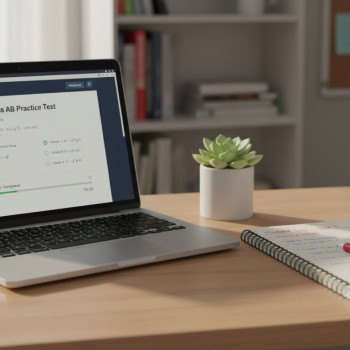Why Stacking APs Can Be Brilliant — and When It’s Not
Taking multiple AP courses can feel like standing at the edge of a pool on a hot day: tempting, invigorating, and a little terrifying. For many students, stacking APs opens doors — deeper college credit, a stronger academic profile, and the chance to explore subjects you love at a higher level. But stacked poorly, APs can drain your energy, harm grades, and make senior spring feel like a sprint through molasses.
This post is a practical, compassionate playbook for stacking APs without collapse. We’ll cover how to choose the right mix of courses, how to schedule your time and exams, how to create sustainable study rhythms, and how to get help when you need it — including a natural mention of Sparkl’s personalized tutoring options where it fits. There’s no one-size-fits-all answer here; instead, you’ll find frameworks you can tailor to your goals, personality, and life outside school.

Start With Purpose: Why Are You Taking Multiple APs?
Before you sign up for anything, ask yourself three honest questions:
- What are my academic and college goals? (Credit, challenge, specialty?)
- How will APs fit with my other commitments? (Sports, jobs, family, mental health.)
- What’s my learning style? (Do I thrive with heavy reading? Need project-based work?)
Your answers form the north star for every following decision. Want college credit? Focus on APs your prospective majors accept. Love writing and analysis? Pair AP English and APUSH or AP Government. Need flexibility? Choose a mix of shorter workload APs and a discipline you enjoy to keep motivation high.
Balance Over Bravado: How Many APs Is Too Many?
There’s no magic number. Some students manage three APs and ace them while keeping an active social life; others do best with one or two. Rather than fixate on quantity, aim for balance: a course load that challenges you but leaves room for recovery, extracurricular growth, and sleep.
Here’s a simple decision framework:
- Start with your baseline: If you’ve never taken an AP before, begin with one or two.
- Add gradually: If you earned A/B in early APs and kept time commitments steady, consider adding one more next year.
- Factor in spring intensity: Many APs have heavy end-of-year assessments. If you plan to take four or more, make sure exam dates don’t cluster into a single week for you.
Real-World Comparison
Think of APs like weights at the gym. You wouldn’t jump from empty bar to heavy plates overnight — you’d build strength gradually, tune your form, and let your body recover. Same with APs: build academic stamina, refine study technique, and protect rest.
Smart Pairing: Choose Courses That Reinforce Each Other
Course pairing is one of the best ways to stack efficiently. Some AP pairings create synergy — the skills you practice in one course help you in another — reducing overall cognitive load.
- AP English Language + AP United States History: Both demand persuasive writing, synthesis of evidence, and strong reading strategies.
- AP Calculus AB + AP Physics 1: Calculus gives you mathematical tools useful in physics problem solving.
- AP Biology + AP Chemistry: Overlapping concepts in biochemistry and lab skills can reinforce learning if paced deliberately.
- AP Psychology + AP Statistics: Statistics strengthens your ability to interpret research methods and data in psychology.
When you pick complementary courses, study time becomes additive rather than multiplicative. Concepts intersect — you learn once and apply twice.
Calendar-Smarts: Schedule the Year, Then the Week
High-level planning prevents last-minute pileups. Use a two-level approach: a yearly exam map, then a weekly rhythm.
1) Build an Exam Calendar
Map out your AP exam dates and key project deadlines. Many exams occur in the first two weeks of May, and some subjects have late testing windows if there are conflicts. If two exams fall on the same date and time, you’ll often have the option to take one during late testing. Talk with your AP coordinator early to understand how late testing works at your school.
2) Create a Weekly Rhythm
Design a weekly flow that balances classwork, AP-specific study, and recovery. A sample rhythm might look like this:
- Monday: Light review for all APs (30–45 min each), deeper focus for one subject (90 min)
- Tuesday: Practice problems / timed writing for Subject B
- Wednesday: Group study / lab review; catch up on missed work
- Thursday: Practice exam sections (30–60 min) + targeted review
- Friday: Light review + reflection on wins and struggles
- Weekend: One long block (2–3 hours) for the trickiest AP, and recovery time
Rotate which AP gets the deep weekly block so no subject is ignored for weeks at a time.
Weekly and Daily Study Strategies That Stick
Consistency beats marathon cramming. Here are proven techniques that reduce friction and improve retention:
- Active Recall: Test yourself — flashcards, practice questions, or recalling a concept in writing for five minutes.
- Spaced Repetition: Revisit topics on a schedule (1 day, 3 days, 1 week, 3 weeks) to move learning into long-term memory.
- Interleaving: Mix problem types or subjects in a single session to enhance flexible thinking.
- Timed Practice: Simulate exam conditions for a section to build pacing and reduce test-day anxiety.
- Peer Teaching: Explain a concept to a classmate; teaching is one of the fastest ways to identify gaps.
Make Time for Reflection
Once a week, spend 20 minutes answering three simple questions:
- What went well this week?
- What was painful or confusing?
- What is one concrete change I’ll make next week?
Reflection keeps you adaptive. Small course corrections compound into big benefits over a semester.
Quality Over Quantity: How to Prioritize Topics
Not all content is created equal. Focus on high-yield topics — the units and skills that frequently show up on AP exams and that underpin other units.
- Review previous exam rubrics and practice exams to identify recurring themes.
- Prioritize mastery of core skills (e.g., argumentation for English, graph analysis for sciences).
- When time is short, choose depth in one key area over superficial familiarity with many.
Use a Table to Compare Workloads and Strategy
Here’s a sample snapshot comparing three APs for a student managing three courses (example weekly time estimates). Adapt the numbers to your pace.
| AP Course | Weekly Class Time | Independent Study / Homework | Exam Prep (monthly) | Suggested Study Focus |
|---|---|---|---|---|
| AP Biology | 5 hours | 6–8 hours | 4–6 hours (practice FRQs) | Concept maps, lab reports, high-yield diagrams |
| AP English Language | 4 hours | 4–6 hours | 3–4 hours (timed essays) | Argument structure, rhetorical devices, timed essays |
| AP Calculus AB | 4–5 hours | 5–7 hours | 3–5 hours (problem sets) | Problem sets, derivations, application practice |
Note: These are estimates. Your actual time may vary depending on teacher pacing, lab requirements, and how comfortable you feel with foundational skills.
Manage Energy, Not Just Time
Time management is necessary, but energy management is the secret sauce. Sleep, nutrition, and movement influence learning more than one more hour of low-quality study.
- Protect 7–9 hours of sleep per night, especially before practice exams.
- Break study sessions into 45–60 minute blocks with 10–15 minute breaks to reset focus.
- Use short physical activity (a walk, a quick set of jump squats) to reboot after mental fatigue.
When to Ask for Help — And How to Ask Smart
Asking for help early is efficient. Don’t wait until concepts pile up. Here are direct, effective ways to get support:
- Make a focused question list before office hours — show what you attempted.
- Form study groups with clear agendas: 30 minutes for review, 30 minutes for practice problems.
- Consider targeted tutoring for stubborn areas; short, regular sessions are often more effective than marathon cram sessions.
Some students find structured 1-on-1 support transforms their trajectory. Sparkl’s personalized tutoring, for example, offers tailored study plans, expert tutors, and AI-driven insights that can help you focus on weak spots without wasting time on what you already know. If you opt for tutoring, pick a program that emphasizes short-term goals, regular feedback, and study-plan adjustments based on practice exam performance.
Exam Month: How to Peak Without Burning Out
The month before exams is about precision. Switch from broad learning mode to targeted polishing. Use practice exams under timed conditions, prioritize weak question types, and protect your final weeks with smart pacing.
- Reduce new content intake two weeks before exams; focus on practice, synthesis, and exam strategies.
- Schedule at least one full-length practice exam per subject under timed conditions.
- Review mistakes with a corrective plan: What went wrong? Which skill caused the error? How will you fix it?
Also: confirm logistics. Know your exam location, the start time, permitted materials (graphing calculators, rulers, etc.), and any digital exam procedures. If two exams conflict, late testing is often an option — communicate with your AP coordinator early to arrange it.
Dealing With Overlap, Conflicts, and Late Testing
Sometimes schedules clash — two exams at the same time, or a heavy project deadline overlapping with an exam window. When that happens:
- Talk to your AP coordinator right away. Schools can request late testing for one of the exams.
- If you face a concentrated exam week, reallocate study blocks in the two weeks prior so each subject gets at least one serious timed practice session.
- Use collaborative study to reduce prep time: swap summaries, outline the differences between units, and quiz one another.
Culture and Well-Being: Keep Life Outside APs Alive
AP success is best measured by sustainable growth, not crisis-induced grades. Keep time for friends, creative outlets, and rest. Burning out in junior year rarely impresses admissions committees as much as consistent growth and reliable academics.
- Schedule at least one non-academic activity you enjoy each week.
- Use short mindfulness or breathing exercises before study sessions to sharpen focus.
- If stress mounts, talk to a counselor, trusted teacher, or mentor — mental health matters as much as GPA.
Examples: Two Student Profiles and How They Stack APs
Seeing examples helps turn advice into lived strategy. Here are two realistic student profiles and recommended approaches.
Profile A: The Aspiring Engineer
Strengths: Loves math and physics, strong time management, plays club soccer.
Suggested Plan:
- Year 1 (Junior): AP Calculus AB, AP Physics 1, AP Computer Science Principles. Emphasize problem sets and lab time.
- Year 2 (Senior): AP Calculus BC (if available), AP Physics C or AP Computer Science A, plus one humanities AP chosen for balance.
- Support Strategy: Weekly problem sets, timed FRQ practice, and occasional 1-on-1 sessions for calculus proofs or physics concepts. Consider short tutoring blocks for AP Physics 1 labs and calculus application problems.
Profile B: The Humanities Polymath
Strengths: Strong writing, active in debate and school newspaper, involved in theater.
Suggested Plan:
- Year 1 (Junior): AP English Language, AP United States History, AP Psychology (lighter science alternative that still yields college credit).
- Year 2 (Senior): AP English Literature or AP Government, AP Statistics or AP Economics if interested in quantitative skills.
- Support Strategy: Timed essays, rhetorical analysis practice, and collaborative peer review. Targeted tutoring can help refine thesis structure and evidence use.
Tools and Low-Effort Routines That Pay Off
Small systems reduce decision fatigue. Try a few of these:
- Color-coded notebooks for each AP subject so everything is visually organized.
- One index notebook for “errors and fixes” where you write a short note about each mistake and how to avoid it next time.
- Digital timers and calendar blocks — schedule five focused sessions a week rather than hoping to study spontaneously.
How Personalized Tutoring Can Fit Naturally Into Your Plan
Not every student needs tutoring, but many benefit from targeted, regular support — especially when juggling multiple APs. The best tutoring models focus on:
- Diagnosing weak spots with practice exams;
- Designing a short-term, measurable plan (for example, bring essay score from 3 to 5 in 10 weeks);
- Providing accountability and feedback loops.
Sparkl’s personalized tutoring — with 1-on-1 guidance, tailored study plans, expert tutors, and AI-driven insights — can simplify the stacking process by turning nebulous problems into clear, actionable tasks. When tutoring fits your schedule and addresses the highest-impact weaknesses, it reduces study time waste and increases confidence.
Final Checklist: Before You Commit to Another AP
Run through this quick checklist before adding a new AP to your plate:
- Do I have one peer or adult who can advise me on this choice? (Teacher, counselor, mentor)
- Will this course pair logically with at least one of my other classes?
- Can I protect 6–8 hours per week for it without sacrificing sleep or key commitments?
- Do I have a backup plan if the workload becomes too much (drop, switch to audit, or reduce extracurriculars)?
- Have I checked the exam calendar and confirmed there are no unavoidable conflicts?
Parting Thought: Choose Momentum Over Momentum Pressure
Stacking APs is not a badge of honor; it’s a tool. The smartest students use APs to build momentum toward learning, not to signal endurance. Choose courses that match your intellectual curiosity and long-term goals. Add support where it multiplies your time — a focused tutor for a stubborn topic, a weekly study group, or a simple error log that stops the same mistakes from repeating.
When you plan with purpose, balance your calendar carefully, and prioritize health and recovery, you can stack multiple APs and still have energy left for the things that make high school meaningful. If you feel unsure, start small, measure progress, and iterate — that’s how lasting success is built.

Quick Resources (Your Short-Start Toolkit)
Keep this mini checklist handy as you decide and plan:
- Exam calendar and your school’s AP coordinator contact
- Weekly planner with two deep-focus blocks reserved for rotating APs
- One practice exam per subject per month leading up to April, then weekly in April–May
- An errors notebook for permanent learning gains
- If you choose tutoring: a 6–8 week measurable goal, 30–60 minute focused sessions, and weekly checkpoints
Need a Personalized Plan?
If you’re juggling multiple APs and want a personalized, step-by-step plan, consider a short diagnostic — either a practice exam or an hour of focused tutoring. Personalized programs help you spend less time wondering what to do and more time doing what actually moves the needle.
Good luck — you can build mastery and keep your balance. The goal isn’t just to pass AP exams; it’s to grow as a learner who can take on new challenges with curiosity and calm.
























No Comments
Leave a comment Cancel